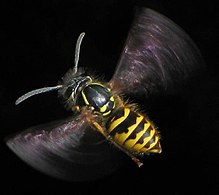
Vespula vulgaris

Vespula vulgaris, known as the common wasp, is a wasp found in various regions, including the United Kingdom, Germany, India, China, New Zealand, and Australia. It is sometimes known as the European wasp, but the same name is used for the species Vespula germanica, which is also known as the German wasp. Another name for Vespula vulgaris is the common yellow-jacket. In 2010, wasps in North America thought to be Vespula vulgaris were found to be a different species, Vespula alascensis. Vespula vulgaris is a eusocial vespid that builds its grey paper nest in or on a structure capable of supporting it. A founding queen searches for a hollow tree, wall cavity, rock crevice, or even a mammal-made hole to build a nest. One colony cycle lasts for about 6–11 months and each colony cycle consists of around 3000–8000 larvae. The extraordinary adaptation skills of V. vulgaris enable it to live in a wide range of habitats, from very humid areas to artificial environments such as gardens and human structures. This species, along with other wasp species such as V. germanica, has impacted the ecosystem, especially those in New Zealand and Australia, where they were imported by humans, and frequently cause damage to fruit crops and endanger humans. The name Vespula vulgaris comes from the origin of the word vulgaris, which means 'common' in Latin, therefore giving the name, the common wasp. This species has many synonyms such as the 'common wasp', 'European wasp', Paravespula vulgaris, or the 'common yellow jacket'. However, a study from 2010 revealed that V. vulgaris and the common yellow jacket are actually two different species, the latter known as V. alascensis. It is closely related to another wasp species, V. austriaca, and is considered a sister group. Common wasps are colloquially called 'jaspers' in some English regions (Dorset, Lincolnshire, and elsewhere in the English Midlands); whether this comes from the Latin vespa or from the abdomen resembling the striped mineral jasper, is not clear. Adult workers of V. vulgaris measure about 12–17 mm (0.47–0.67 in) from head to abdomen, and weigh 84.1±19.0 mg, whereas the queen is about 20 mm (0.79 in) long. It has aposematic colors of black and yellow; yellow pronotal bands which are almost parallel to each other and black dots and rings on its abdomen. The queens and females appear very similar to Vespula germanica), except when they are seen head on, as the V. vulgaris face lacks the three black dots of V. germanica. Instead, each has only one black mark on its clypeus, which is usually anchor or dagger-shaped. However, identification of this species may be difficult because the black mark on its clypeus can sometimes appear broken, making it again look similar to V. germanica. Still more difficult to distinguish between species are the males. Almost undetectable with the naked eye, the only confident identification of V. vulgaris males is to seek the distinct aedeagus tip shapes and lateral processes of their genitalia. V. vulgaris is a Palearctic species. It was discovered in a wide range of countries, including the United Kingdom, Germany, India, and China. It is invasive in New Zealand and Australia. Until 2010, it was thought to be in North America as well, but molecular and morphological data showed that specimens identified as V. vulgaris in North America were from the separate species Vespula alascensis.
